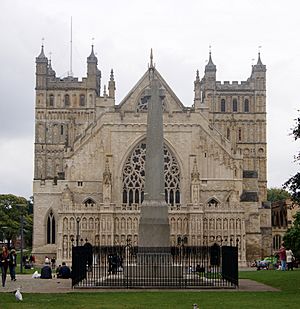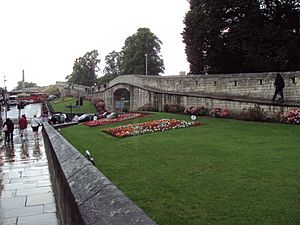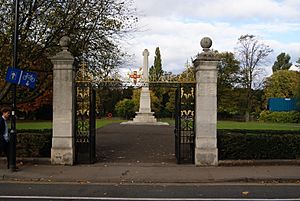York City War Memorial facts for kids
Quick facts for kids York City War Memorial |
|
|---|---|
| United Kingdom | |
 |
|
| For servicemen from York killed in the First World War | |
| Unveiled | 1925 |
| Location | 53°57′35.7″N 01°05′22.4″W / 53.959917°N 1.089556°W Leeman Road, York, England
|
| Designed by | Sir Edwin Lutyens |
|
Listed Building – Grade II
|
|
| Official name | York City War Memorial in the War Memorial Garden |
| Designated | 10 September 1970 |
| Reference no. | 1257512 |
The York City War Memorial is a special monument in York, England. It was built to remember the brave soldiers from York who lost their lives in the First World War. A famous architect named Sir Edwin Lutyens designed it.
After the war ended in 1918, people in York wanted a way to remember those who died. Discussions started in 1919, but it took a while to agree on what kind of memorial to build. Some people thought it should be a useful building, like a new hospital or a bridge. Others believed it should be a monument, a statue or structure just for remembering.
In January 1920, everyone finally agreed on a monument. The city asked Sir Edwin Lutyens to design it. He was already working on another war memorial in York for the North Eastern Railway (NER), a big train company.
Lutyens' first design for the city memorial was approved. However, some people worried that both the city's and the railway's memorials would not fit well with York's old buildings, especially near the ancient city walls. They also thought the railway's memorial might be too big and make the city's memorial look small. Because of these concerns, the plan changed. The committee chose a new spot on Leeman Road, just outside the city walls. Lutyens then created a new design, which was a War Cross and a Stone of Remembrance. But due to not enough money, they could only build the cross.
Prince Albert, Duke of York (who later became King George VI) officially revealed the memorial on June 25, 1925. This was six years after the idea for the memorial first started. The memorial is a stone cross about 33 feet (10 meters) tall. It stands on several stone blocks and steps. It is located in a peaceful memorial garden. The entrance to this garden was also designed by Lutyens using the money left over. The memorial is a very important historical building, listed as Grade II*. This means it is protected and recognized for its special history and design.
Contents
Remembering the Past: Why War Memorials?

After the First World War, over a million British soldiers died. To remember them, thousands of war memorials were built across Britain. One of the most famous designers of these memorials was Sir Edwin Lutyens. He is known as one of the best English architects of his time.
Lutyens designed many important memorials. These include The Cenotaph in London, which is a national monument. He also designed the Thiepval Memorial to the Missing, the largest British war memorial in the world. He created the "Stone of Remembrance," a special stone found in many large cemeteries for soldiers.
The York City Memorial was the fifteenth and last "War Cross" designed by Lutyens. Most of his War Crosses were for small villages. The Devon County War Memorial in Exeter is the only other one in a city.
Planning the York memorial was difficult from the start. A committee was formed in May 1919 to oversee it. They started collecting donations in August. But it took six years for the memorial to be finished.
One big debate was whether the memorial should be a monument or a useful building. Many communities had this same discussion. Ideas included a new city hall, a hospital, or homes for war widows. The committee even thought about a new bridge or a maternity hospital. After many public meetings, everyone agreed in January 1920 to build a monument.
The committee asked the city engineer to design a memorial garden with an archway and a cenotaph (an empty tomb). The engineer estimated it would cost about £7,000. Then, the committee hired Lutyens to lead the project. Lutyens was already designing a memorial for the North Eastern Railway Company (NER). This company was based in York and wanted to honor its staff who died in the war.
Choosing the Location and Design

The committee gave Lutyens a budget of £2,000 in 1920. Lutyens visited York in August 1920 to look at nine possible sites. He liked a former burial ground outside the city walls best. But the committee chose his second choice. This was a spot inside the walls, near Lendal Bridge. It was about 100 yards (91 meters) from where the NER's memorial was planned.
Lutyens sent his design to the committee. It featured his "Stone of Remembrance" on a tall platform, raising it 18 feet (5.5 meters) off the ground. This was a very ambitious design. The committee approved it in June 1920. The design was shared in local newspapers for public feedback. It was finally approved at a public meeting in November 1920.
However, some people still had concerns. The York Archaeological Society felt the design did not fit with York's old city walls. They also thought it would block views for people entering the city. Others worried that the city's memorial would be overshadowed by the railway company's. The NER had given Lutyens £20,000 – ten times the city's budget! For that money, he planned a 54-foot (16.5-meter) tall obelisk and a large wall.
Because both memorials were so close to the city walls, they needed approval from the Ancient Monuments Board. This board protects old buildings. Even after the board approved the city's plan, public opposition grew. The committee had to rethink the location.
They looked again at a site on Leeman Road, outside the city walls. Lutyens' assistant visited the site in August 1923, and everyone agreed it was a good spot. The London and North Eastern Railway (which the NER had joined) owned the land. They generously donated it to the city. Lutyens then created a new design for this location: a War Cross and a Stone of Remembrance. This would have cost almost £2,500. But because of limited funds, they decided to build only the cross. The city council used its own staff to build it to keep costs under £1,100, which was the amount raised by public donations.
The Memorial's Look and History
The York City War Memorial was officially revealed on June 25, 1925. Many people came to the ceremony. Prince Albert, the Duke of York (who later became King George VI), unveiled the memorial. The Archbishop of York gave a special dedication. Earlier that day, the Duchess of York had unveiled a window in York Minster dedicated to women who died in the war.
The memorial is made of Portland stone. It is a cross about 33 feet (10 meters) high. The cross has short, angled arms and stands on four rectangular blocks. Below these blocks are more stone layers and two shallow steps.
The largest block has the only words on the memorial. On one side, it says: "TO THE CITIZENS OF YORK 1914 – 1918, 1939 – 1945." The dates for the Second World War were added later. On the other side, it says: "THEIR NAME LIVETH FOR EVERMORE." As a special memory, a bottle, some coins, and a newspaper were placed inside the memorial structure. The memorial is in a garden on the south bank of the River Ouse. It looks out over the river and the old ruins of St Mary's Abbey.
In April 1926, after all the building costs were paid, £400 was left in the memorial fund. Lutyens' fee was £122, and his expenses were £20. With the remaining money, the committee asked Lutyens to design the entrance gates and two tall pillars for the memorial garden. The pillars are made of limestone with decorative tops. The gates are iron, painted black and gold. They have the City of York's coat of arms above them. The gates open towards the memorial. To use up the very last of the money, the committee bought three wooden benches for the garden.
The York City War Memorial was given a special "Grade II" listed building status on September 10, 1970. This means it is protected from being changed or torn down. The gates and pillars were listed separately as Grade II in 1983. The nearby NER memorial was listed as Grade II* in 1970.
In November 2015, during the 100th anniversary of the First World War, Lutyens' war memorials were recognized as a national collection. Many of his memorials in England had their protection status reviewed. The York City memorial was upgraded from Grade II to Grade II*. This shows how important it is to the country's history.
Images for kids
-
The Devon County War Memorial in Exeter was also designed by Lutyens. It is one of the few War Crosses by him in a city.
-
The York city walls near Lendal Bridge, close to where the City War Memorial was first planned. The North Eastern Railway Company's memorial is visible in the background.





